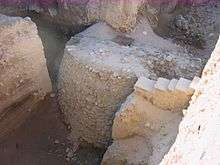Tower of Jericho
The Tower of Jericho is an 8.5-metre-tall (28 ft) stone structure, built in the Pre-Pottery Neolithic A period around 8000 BCE.[1] It is among the earliest stone monuments of humanity.[2]
 | |
 Shown within the Palestinian territories | |
| Region | West Bank |
|---|---|
| Coordinates | 31.872041°N 35.443981°E |
| Type | Tower |
| Height | 8.5 m (27.9 ft) |
| History | |
| Periods | PPNA |
| Cultures | Sultanian |
| Site notes | |
| Excavation dates | 1952–1958 |
| Archaeologists | Kathleen Kenyon, Roy Liran and Ran Barkai |
| Condition | Ruins |
The Wall of Jericho was discovered by John Garstang during the excavations of 1930 to 1936, which he suggested were those described in the Book of Joshua in the Bible and dated to around 1400 BCE.[3] Kathleen Kenyon discovered the tower built against the wall inside the town during excavations between 1952 and 1958, in trench I. Kenyon provided evidence that both constructions dated much earlier, to the Neolithic, which is the latest part of the Stone Age, and were part of an early proto-city.[3] The tower highlights the importance of Jericho for the understanding of settlement patterns in the Sultanian period in the southern Levant.[4]
Structure
The tower was constructed using undressed stones, with an internal staircase of twenty-two steps. Conical in shape, the tower is almost 9 metres (30 ft) in diameter at the base, decreasing to 7 metres (23 ft) at the top with walls approximately 1.5 metres (4.9 ft) thick. The construction of the tower is estimated to have taken 11,000 working days.
Purpose
The Tower has been interpreted as a fortification, an anti-flooding system, a ritual centre and a political symbol of communal power and territorial claim.
Recent studies by Ran Barkai and Roy Liran from Tel Aviv University have suggested astronomical and social purposes in the construction of the tower. Showing an early example of archaeoastronomy, they used computer modelling to determine that the shadow of nearby mountains first hit the tower on the sunset of the summer solstice and then spread across the entire town.[2] Noting that there were no known invasions of the area at the time of construction, the defensive purpose of the tower, wall and ditch at Jericho has been brought into question. No burials were found and suggestions of it being a tomb have been dismissed.
Discussing in the Jerusalem Post, Barkai argued that the structure was used to create awe and inspiration to convince people into a harder way of life with the development of agriculture and social hierarchies. He concluded: "We believe this tower was one of the mechanisms to motivate people to take part in a communal lifestyle."[1]
See also
- List of megalithic sites
References
- O'Sullivan, Arieh., World’s first skyscraper sought to intimidate masses, Jerusalem Post, 14 February 2011
- Parry, Wynne., Tower of Power: Mystery of Ancient Jericho Monument Revealed, LiveScience, 18 February 2011
- Geoffrey W. Bromiley (13 February 1995). International Standard Bible Encyclopedia: A-D. Wm. B. Eerdmans Publishing. pp. 275–. ISBN 978-0-8028-3781-3. Retrieved 9 July 2011.
- Aedeen Cremin (1 November 2007). Archaeologica. frances lincoln ltd. pp. 209–. ISBN 978-0-7112-2822-1. Retrieved 9 July 2011.
External links
| Records | ||
|---|---|---|
| Preceded by Tell Qaramel |
World's tallest structure[1] c. 8000 BCE - c. 2650 BCE 8.5 m |
Succeeded by Pyramid of Djoser |
- "Esra Magazine - THE ROUND STONE TOWER OF JERICHO". www.esra-magazine.com. Retrieved 25 November 2016.